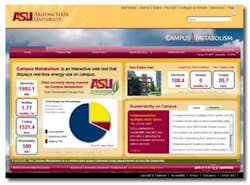ASU Gets Greener through Visibility
As the old adage says, if you don't measure it, you can't control it. That is the fundamental principle behind Arizona State University's energy monitoring system. At ASU they take it one large step further—they show it off to the world.
Energy costs are a major factor in Arizona, both in the summer and the winter. ASU is the equivalent of a small city, with a population of 69,000. In the world of Greener Thinking, universities play an important role in educating the citizens of the future. ASU takes this responsibility very seriously.
ASU has been a long-time proponent of Greener Thinking and has taken steps in many areas, from 1.3 Megawatts of photovoltaic panels to generate supplemental AC power, to running its own 7 Megawatt power plant for the generation of electric power. In addition, the ASU Tempe Campus runs two chilled water plants to assist in the cooling of various campus buildings. All this energy use is made visible through ASU's Energy Information System and a Campus Metabolism website.
In 2004, ASU decided energy accounting needed to be stepped up and made very visible, to promote both conservation and education. This required the installation of utility-grade instrumentation to properly and accurately monitor a building's usage. From the gathering of this data, the Energy Information System (EIS) was born.
System Payback
Today, over 50 campus buildings are being monitored by the EIS system. This equates to over 1,000 variables, but covers only about one-half of the overall campus. The process of instrumentation and monitoring has been very successful and will continue. To date, energy monitoring before, during and after energy savings programs has resulted in a 20 percent reduction in energy usage and an overall payback within six to seven years.
In 2007, ASU took the success of EIS to the masses with the creation of Campus Metabolism.
This flash-based web application pulls from the same database as EIS in order to create an educational environment that not only shows ASU's dedication to Energy Savings, but also creates an environment where students and the population as a whole can learn how to be more energy conscious.
Energy savings have come in many forms, from improved insulation on steam lines, to the installation of more efficient lighting fixtures. Energy savings have also come in the form of renewable resources such as solar power. Currently, ASU generates over 1.7 Megawatts of DC electricity through the use of solar cells. This power is directly converted to AC power, generating 1.3 Megawatts to supplement electricity at peak times of use, such as daylight hours. In addition, a substantial savings can be realized by using electricity during off-peak periods when rates are up to 40 percent less expensive. ASU manages a 5 million gallon thermal energy storage facility where water that is chilled during the night can be used for cooling the next day. Other savings come from the modernization of controls, from old pneumatic systems to modern Direct Digital Control (DDC) systems.
The project involves more than energy savings—it involves the education of students on campus, making them more aware of their energy use and how they can contribute to savings. To bring the message closer to home, ASU developed the "Virtual Room" demonstrating a living quarters and an office. Complete with pan, zoom and the ability to turn various products on and off, such as lighting, computers, refrigerators, etc., students have the ability to see and instantly understand the cost-per-month implications of their actions.
Robert Vandling, Senior Technology Support Analyst responsible for the Building Controls technology and this energy savings program, shared some additional details on the EIS architecture. While many protocols are required to talk with all the systems on campus, the most prevalent protocol used as a common denominator was Modbus Ethernet. However, as the program focuses more in the intricacies of building operation, BACnet may become equally as important.
OPC Eases Scale-up
When first approaching this project, Vandling sought the recommendations of several controls experts in order to choose the best communications solution. The recommendation was Kepware's KEPServerEX communication solution. It delivered one OPC Server able to communicate with a variety of automation protocols. Its runtime programming and productivity tools, such as import and export, facilitated a quick and accurate scale-up to a full implementation. The proof of a successful selection came easily during a 30-day trial period when, without personnel training, the software was installed and put through its paces without issue.
This project has garnered a great deal of interest from students and visitors alike. It will be featured during a tour sponsored by the GREENBUILD International Conference and Expo, November 11-13, 2009. In the latest "Princeton College Review," ASU was selected as one of the "Greenest" Universities in the "2010 Green Rating Honor Roll."
To read the full article, click here.

